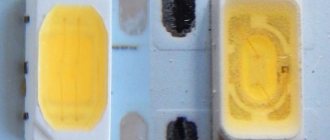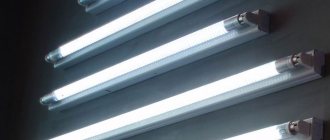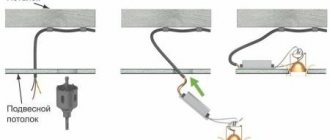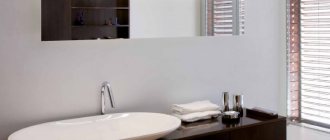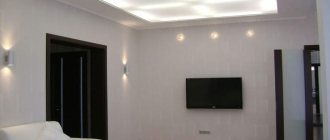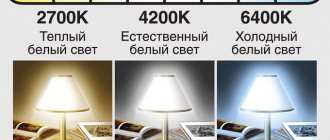Lighting is an important part of the design of any room. Recently, LED ceiling lights have become extremely popular, which we will talk about next.
For 10 years now, LED lighting has become increasingly popular, and LED ceiling devices make it possible to obtain concentrated, bright light at low energy costs and with a complete absence of flicker.
There are several types of diode devices - strips, soffits, panels, mortise, suspended and overhead.
Lamp shapes
There are three types of samples, which are divided precisely by installation methods:
- Built-in. In most cases, this lighting device is a spotlight. It is very rare to see huge lamps or unusual figures. This sample will be more compact than other types. Their bodies are installed in the surface. External parts, in rare cases, can either protrude or be at ceiling level.
- Invoices. They can be mounted on the surface. The selection of these lighting devices is huge. These lamps have different shapes, sizes and designs, which does not limit the buyer’s choice.
- Hanging. This type is attached to the ceiling on cables or power cords. Their convenience is evident in the fact that this model can be adjusted. Typically, these lighting fixtures are used as lighting for tables, mirrors, reading areas and other similar places. To use general lighting, pendants should be purchased with powerful light. They will scatter the rays throughout the area due to different directions.
In addition, thanks to ceiling lighting fixtures, you can create different types of lighting:
- Scattered. This lighting can be provided by models with special diffusers or with a matte shade. With this light, there will be no sharp shadows in the room, and the light will fall evenly and at wide angles.
- Directed. Such light can create unusual shadows on objects, so it can also be called drawing light. These lighting devices are used to illuminate the work area, creating interesting accents in rooms or on details.
- Reflected. These models direct beams at the ceiling and walls rather than at objects. The light hits them by rays that have already been reflected from the surfaces. This light is very pleasing to the eye and is used as a general light.
In addition, these light sources can also be divided by the number of lamps and their types, by purpose, by degree of protection and by design.
What kind of lighting do you prefer?
Built-in Chandelier
Malfunctions
- Power supply failure. The malfunction of the device may be due to a burnt-out resistor or capacitor. This type of breakdown is complex, so repairs must be carried out by a specialist.
- LED burnout. The cause may be a power outage or a capacitor breakdown. For lamps containing a large number of LEDs, the burnout of one element may not be noticeable, but with a series connection, the broken component must be found and replaced.
- Driver failure. This problem is indicated by one or more LEDs blinking.
- Incorrect operating conditions. Before purchasing a device, it is important to study its instructions and make sure that the operating conditions are suitable for this lamp.
- Overheat. Occurs at temperatures above 50C. Leads to broken contacts or damage to the holder itself.
If you need to repair electrical equipment yourself, you must choose tools with protection. It is prohibited to repair devices with tools not protected by rubber!
Type of luminous flux control
Based on the type of luminous flux regulation, there are two types of LED lamps:
- Devices with the function of adjusting color temperature and changing color. A dimmer and control panel are used for adjustment.
- Single color non-tunable LED lamps. The lighting can be controlled using a compatible general purpose controller.
An LED chandelier dimmer is a small device with which you can smoothly adjust the brightness and color of the light output. We don’t always need bright lighting in our apartment; a dimmer allows us to reduce it to a comfortable level depending on the situation. Depending on the control method, dimmers are divided into mechanical, remote, electronic and acoustic.
The dimmer was invented not only for the purpose of regulating the light flux; one of its most important tasks is to protect the chandelier from voltage surges in the network.
What other functions besides remote control do dimmers perform:
- automatic switching off and switching on of the device by timer;
- automatic switching off and switching on of the device according to a configured electronic program;
- simulating the presence of a person in a room;
- regulation of dimming and blinking modes.
As we have already said, LED lamps are very economical in terms of energy consumption. Automatic dimmers also help save energy consumption: the device adapts to natural light, providing exactly the level of light that is needed at the moment - no less, no more.
In non-tunable single-color LED luminaires with built-in drivers, the luminous flux is controlled by general-purpose dimmers. To control the light flux, PWM (pulse width modulation) is used.
Expert opinion
It-Technology, Electrical power and electronics specialist
Ask questions to the “Specialist for modernization of energy generation systems”
Which lamps are better for a suspended ceiling - 3 comparison options Ceiling lamps for the industrial sector are impressive in their size, but they must shine brightly enough for workers to see everything; Ask, I'm in touch!
Advantages and disadvantages of ceiling lamps: characteristics
LED light sources have been developed as a cost-effective alternative to other lighting fixtures.
To verify the truth of this, you should study their advantages and disadvantages. Advantages:
- The most important advantage is cost-effectiveness. With the help of LED light sources, 22% of electricity is converted into light - this is 10 times higher than incandescent lamps. Also, the luminous flux of LEDs is 8-10 times higher, making them brighter than traditional lighting sources.
- Low heat generation.
- A certain direction of the light flux, which affects the brightness of the lighting.
- Environmental friendliness and safety - the lamps do not contain mercury, incandescent filament and other dangerous fragile elements.
- No flicker.
- Small dimensions.
Flaws:
- High price.
- Temperature range limitation – LEDs operate correctly at temperatures no higher than +50C.
Color temperature of LED chandeliers
LED lamps are capable of imparting a certain shade to the room (cold or warm tones) using the color of the luminous flux. Color temperature is measured in Kelvin (K); when selecting a lamp, you must take this indicator into account.
A warm shade of lighting (2700-3300 K) is ideal for the bedroom and all places where a person is used to relaxing. The light has a soft yellowish tint (slightly dimmer than daylight).
The daytime shade (4000-4200 K) invigorates and improves performance; it is suitable for an office or kitchen.
They also emit a cold, bluish tint (5000 K). When exposed to light in a room for a long time, a person's eyes get tired of it.
Popular manufacturers
LED lamp Philips LivingColors Mini
The leading positions in the market of LED products are occupied by Phillips and Osram. They offer high quality products with components that meet international standards. All products have appropriate certification. Lamps from these two companies are the most reliable and can withstand intense operating loads. LED sources from Phillips and Osram are more expensive than analogues from other manufacturers.
Outdoor and household goods of high quality at an affordable price are produced in Russia. They offer products of various configurations, including modules built into furniture.
Recently, the Russian company Era appeared on the market. Their products have already become popular with customers due to their high quality and affordable price. The company is actively developing and improving product characteristics, so in the near future it will be able to get ahead of its competitors in the battle for customers.
What are the benefits of LED chandeliers?
The types of LED lamps for chandeliers are varied and choosing the right one is not difficult, but first you need to understand why they are good.
- Light bulbs of this type are not hazardous to the environment and are completely environmentally friendly.
- The bulbs are not enclosed in a glass base, which prevents the possibility of breaking and cutting.
- LEDs are designed in such a way that they are not afraid of any temperature conditions, high humidity and other external influences. This makes them suitable for use in homes, apartments, offices, warehouses, and even street lighting.
- Each LED chandelier has a built-in capacitor - a fuse. This makes their operation safe even in conditions of constant power fluctuations, so there is no need for complex, expensive transformers.
- Due to the fact that the bulbs remain completely cold, they can be used with a suspended ceiling. The ceiling film will not be subject to deformation.
- The flickering of light is not noticeable to humans, since ice lamps have a high flickering frequency.
- Lamps of this type do not distort the color rendering process.
- You can choose warm or cold lighting, and if you have additional functions, change the color of the lighting to any other.
- Many LED chandeliers are controllable and this is done using a remote control.
Expert opinion
It-Technology, Electrical power and electronics specialist
Ask questions to the “Specialist for modernization of energy generation systems”
How to choose a chandelier with LEDs Ceiling lights for the industrial sector are impressive in size, but they must shine brightly enough for workers to see everything;. Ask, I'm in touch!
How to choose
The choice of device is made taking into account the following parameters:
- Lamp power.
- The type of material from which the ceiling covering is made.
- Room area.
- Purpose of the premises.
When installing devices on a suspended ceiling, you should pay special attention to the heating level of the lamp. An error in this parameter can lead to melting and damage to the fabric. It is important that the only correct lighting option for a stretch ceiling is LED lamps. Light sources with any power are perfect for suspended structures. But in this case, effective ventilation between the secondary and base ceilings will be required. Ventilation is also needed for polyvinyl chloride ceilings, as well as structures made of plastic slats. The maximum permissible lamp power is 40 W, and if the material is soft and thin, then it is best to choose devices with low power. Low power can be compensated by increasing the number of lamps.
Important advantages of lighting elements
For auxiliary lighting in interiors, LED devices consisting of a semiconductor element and a power source of suitable voltage are popular. The list of their advantages is relatively wide:
- long service life;
- energy saving;
- lack of strong heating during active use;
- compact dimensions;
- clear direction of rays;
- no flicker.
Lamps are installed in the bedroom along the perimeter of the ceiling
Helpful information! The relatively high price may be the most significant drawback. As for other flaws, they cannot be considered significant.
Ripple factor
Ripple, or flicker, of a light source is a very important parameter. Its value for premises should not exceed the range of 20-40%. This phenomenon is caused by the presence of alternating current in the network. Therefore, it can be minimized by using special drivers. There are special instruments to determine this characteristic. However, at home it can be checked with a digital camera. The image of a strongly pulsating LED lamp will appear blurry and dark streaks.
Application area
What kind of LED lamps even exist? The answer to this question is very simple: almost any. Let’s take, for example, an ordinary country house in which it is necessary to organize adequate lighting at minimal cost. The choice of LED lighting in this case is simply huge: street lamps are suitable for the local area, ordinary lamps, for example, ceiling or wall lamps, for living rooms and bedrooms, and the same ones, but with a higher degree of protection, for the bathroom and kitchen.
Wondering which LED ceiling or wall light to choose? It all depends solely on your preferences and budget. There is only one basic rule: you should not trust products from nameless Chinese manufacturers. There are companies in China that have long established themselves in this market on the most positive side, for example, Selecta and Estares. However, the quality of crafts made in the basement in the vast majority of cases leaves much to be desired, and such household appliances usually do not last long. Therefore, it is better to give preference to proven brands, and it is not so important in which country they are registered - Russia, China, Japan or any other.
Main conclusions
The range of LED modules is huge, theoretically anyone can choose the one they need. For lamps used in residential premises, such indicators as the strength and aesthetic appeal of the body are important.
You should not choose light bulbs that do not have a brand name on them. The technical and operational characteristics of such products do not correspond to the declared ones - after a short time the color of the glow changes and the crystal begins to degrade.
If the seller is not ready to provide a quality certificate, it is better to look for another store.
What you need to know about the device
A semiconductor lamp consists of the main parts:
- housings made of plastic or glass;
- base;
- drivers;
- the LEDs themselves.
The main source of light flux is the diode. It is designated as LED in English or LED (light emitting diode) in Russian. The LED is made of a semiconductor, which, as a result of exposure to electricity, emits electromagnetic radiation in the light range. To minimize energy losses in the process, a sapphire substrate is installed in the lamp. This allows you to create a powerful light flow.
Diode lamp circuit
Light propagation ranges from five to one hundred and sixty degrees. The brightness of the LED is constant and is not related to the position of the lamp in space.
The brightness of duralight can be adjusted
LEDs are:
Indicative. Such semiconductors are not reliable and are used in obsolete devices.
Indicators
SMD diodes practically do not heat up and are small in size, which makes them possible to use everywhere.
SMD device
COB diodes are a rapidly developing technology that provides a uniform luminous flux.
SOV diode
Filament semiconductors - one such element produces almost one and a half watts of light energy, and at all three hundred and sixty degrees. The production of filaments is cheap and they are the latest and most promising direction in this production.
Filament diodes
Semiconductor crystals are very small. In lighting devices they are combined into groups. One lamp can contain hundreds of crystals. They are connected by a fiberglass board with tracks that conduct electric current.
Phosphor - a substance that can glow in the dark
The dimensions of semiconductors in indicators require the use of currents not exceeding twenty milliamps. LED lighting lamps are equipped with additional overvoltage protection and special heat sinks. LED light sources emit minimal heat.
Diagram of a 220V LED lamp in the figure:
Detailed semiconductor connection diagram
Operating conditions requirements
In terms of compliance with operating conditions, LED lamps, regardless of their functional type, are regulated in the same way as any other lighting equipment. That is, all products are assigned a certain category according to:
- Type of installation
- ceiling, suspended, console, floor, etc. - Energy consumption class
- there are 7 classes from A to G, but LED technology corresponds to the top two classes (A and B). - Electrical safety class
- from 0 to 3. - Degrees of dust protection (from 2 to 6) and moisture protection (from 0 to

- marked with a two-digit IP index, for example, IP20 (sufficient for clean, dry rooms) or IP67 (for outdoor locations and industrial premises with severe operating conditions).
Types of LED equipment by design features
LED ceiling light.
Hurry up to buy at a discount! Classification by place of use is not all the characteristics of the equipment. There are other important factors. Professionals divide LED devices by design:
Mortise point models. Attached to a rigid ceiling paneling or a specific box (if the ceiling is suspended) - this is the prevention of sagging. Suitable for suspended, slatted and plasterboard ceilings. The power of these devices is up to 24 W.
LED ceiling spotlights
These are compact and durable devices. However, they are completely unsuitable for rooms with high humidity. You will have to get protective shades. The luminous flux of such equipment is narrow, so they are ideal for additional lighting and illumination of certain places in the room.
Overhead and semi-mortise with diffusers. Popular products. Their installation depth is less than that of mortise options. They are usually placed between the stove and the decorative ceiling covering if there is a small space between them.
Such lamps are purchased for powerful light bulbs. Thanks to the diffusers, the light is evenly distributed throughout the room. The equipment is in harmony with multi-colored glossy stretch ceilings. Will appeal to those who love unusual visual effects.
Surface-mounted LED lamps
Soffits. Light sources are located in the moving parts of the illuminator, attached to the ceiling with its base. Not suitable for suspended ceiling coverings. Light from spotlights is represented by narrow buds that illuminate individual points or objects. Rotation of the soffit head in different planes helps illuminate certain parts of the room.
Panels. Overhead, suspended and mortise modifications. Usually these are flat lighting fixtures. Thanks to the diffusing surface, they illuminate the room evenly. A thin surface does not make the ceiling visually lower. There are products of various arbitrary or geometric shapes and dimensions. Living rooms are usually equipped with round and shaped modifications, while offices and utility rooms are equipped with square and rectangular ones.
Suspended LED panels in the interior of the room
About laying wires
When the devices are selected for installation in the room, all that remains is to properly organize the electrical wiring diagram. When developing it, the main points and methods of connecting cables to lighting devices should be taken into account. Before laying wires, you should indicate the location of the elements on the ceiling.
Basic diagram of connecting elements
If LED devices are designed for 12 or 24 volts, then to connect to the main network you will need to purchase a power supply. Its power is selected taking into account the load created by all devices. The parallel connection scheme for lighting elements is mainly used when there are several groups, each of which will be controlled separately using a two-key switch.
The built-in device is connected to electricity

